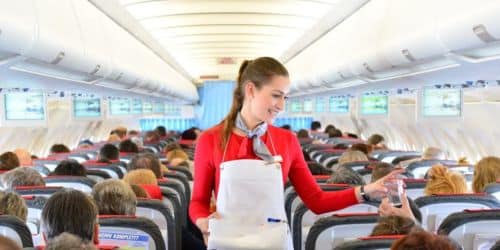One of the factors that ensure a good flight is a warm reception and hospitality. And who does that better than a flight attendant? Here, we’ll see the roles and job description of a flight attendant, the average salary, and how you can become one.
What Is a Flight Attendant?
A flight attendant (also known as an air hostess, stewardess, steward, or host) is a member of the flight crew on commercial flights, many business jets, and some government planes. Flight attendants, also known as cabin crew, are primarily responsible for passenger safety and comfort.
Flight attendants can work in first class, where they provide elaborate service to a small number of passengers, or in economy class, where they provide less elaborate service to a large number of passengers. Service entails attending to a wide range of needs and requests, and flight attendants only have a limited amount of time during the flight to provide the most personalized service possible to each and every passenger.
Job Description Of A Flight Attendant
A Flight Attendant ensures that passengers are safe and comfortable while flying. Their primary responsibilities include performing safety checks prior to flight departure, providing food and beverages to passengers, and demonstrating emergency procedures such as putting on oxygen masks, fastening seat belts, and using exit doors.
Responsibilities and Duties
Flight Attendants are primarily responsible for ensuring the safety of all passengers and that the cabin crew is capable of performing their duties properly. In order to build a positive image of the airline, they must also strive to make flights as comfortable and stress-free as possible for passengers. Flight attendant duties include the following:
- Using emergency and safety equipment to demonstrate its use
- Providing drinks, lunches, and snacks
- Offering special help to passengers with disabilities
- Providing comfort to passengers during airplane turbulence
- In the event of an emergency, administering first aid and medical care
- Giving instructions to passengers, including emergency evacuation methods.
Example of a Flight Attendant Job Description
Here’s an example of a flight attendant job description:
Our corporate airline is looking for an experienced flight attendant to join our passionate flight crew. The flight attendant will be in charge of doing normal safety checks, aiding passengers, and ensuring that each customer has a comfortable and first-rate flying experience. We’re searching for someone with great customer service skills, a passion for travel, and the flexibility to work a flexible schedule on short notice. The ideal candidate will also be able to make good decisions in a fast-paced setting and have excellent communication abilities. Flight attendants must have at least three years of experience and will be trained on the job once recruited.
Flight Attendant Qualifications
You must be at least 18 years old, have a current passport, have 20/40 eyesight, and pass a drug test and background check to be recruited as a flight attendant. You may also be required to pass a medical exam and meet the height criteria of an airline. Flight attendants should provide a professional image and provide good customer service.
Flight attendants must have a high school diploma and, ideally, an associate’s or bachelor’s degree. Some people choose to attend flight attendant school instead of college. You may need to take foreign language classes if you wish to work on overseas planes.
Training
To learn customer service abilities, most flight attendants require a year or two of work experience. Once hired as a flight attendant, they must complete three to six weeks — and in some situations, up to six months — of airline training. Flight attendants study safety and emergency procedures, first aid, flying laws, and job obligations throughout this training time. They also fly practice missions.
To be qualified by the Federal Aviation Administration, all flight attendants must finish this first training (FAA). Depending on the airline, they may be required to complete further job training.
Certifications
Flight attendants must hold one of the following credentials:
FAA Demonstrated Proficiency Certificate
This credential, which flight attendants obtain after completing on-the-job training and passing a test, is required. Flight attendants must undergo training and certification for each type of aircraft they work on. They must also continue to receive training each year in order to maintain their certification.
Flight Attendant Certificate Courses
Certification programs are available from organizations such as the Inflight Institute based on the kind of airline: charter, regional, national, or international. Before being employed, their partner airlines require flight attendants to complete these online courses, which cover topics ranging from aviation vocabulary to safety protocols to passenger management.
Skills
Flight attendants often like working with people and providing excellent customer service. They also enjoy traveling and experiencing new locations, and they are at ease working long or unconventional hours. Flight attendants must have the following skills in order to succeed:
#1. Attention to details
Flight attendants must keep an eye out for any concerns or suspicious actions among passengers. They must also be thorough while inspecting equipment and individuals for safety.
#2. Communication
Flight attendants must communicate clearly and convincingly when conducting safety demonstrations and communicating with passengers and crew. They should also be courteous and good listeners.
#3. Customer service
Customer service is an important aspect of a flight attendant’s work. When offering services, they should be polite and patient in order to guarantee that passengers have a comfortable and enjoyable flight.
#4. Stamina
Flight attendants frequently work long hours, deal with difficult passengers, and handle heavy items like bags and service carts. They are also frequently on their feet.
#5. Efficiency
To ensure an on-time departure, flight attendants must accomplish preflight chores promptly and effectively. They must also provide in-flight services during the time they are in the air.
In an emergency, flight attendants must take command and make swift decisions to guide passengers to safety.
Work Environment for Flight Attendants
Flight attendants might work part-time or full-time. They could be employed by commercial, corporate, regional, or international airlines. They work unusual hours and schedules since airlines operate 24 hours a day, seven days a week, including holidays and weekends. Most airlines limit flight attendants to 12 hours of labor each day. However, international flights may compel them to work longer. Flight attendants must take at least nine hours off between shifts, according to the FAA. They frequently spend nights in motels between flights and may be gone for days at a time.
Flight attendants work part-time in the air and part-time on the ground, preparing for or waiting for the next trip. When flying, they collaborate with other flight crew members in the plane’s cabin. The job of a flight attendant can be stressful at times since they must deal with angry or frightened passengers, respond to emergencies and air turbulence, and stay on their feet for extended periods of time.
Before they may choose their schedule and location, flight attendants normally must accumulate years of experience and seniority. Many flight attendants opt to reside near their base airport so that they can easily drive to work, especially if they are called in on short notice.
How to Get a Job as a Flight Attendant
To become a flight attendant, you must first complete training and certification to confirm your ability to be accountable for the safety and comfort of passengers. The steps to becoming a flight attendant are pretty simple and involve the following:
- Get your high school diploma. A high school diploma is the minimum educational qualification for flight attendants.
- Get a college education. While most airlines can recruit untrained flight attendants, an associate or bachelor’s degree in an area such as public relations may make you more appealing to employers.
- Improve your customer service abilities. Work in a hotel or service position for a year or two to hone your customer service skills. While looking for flight attendant positions, this experience will appear good on your CV. You may work at a restaurant, a hotel, or any other position that demands you to interact with people.
- Apply for a position. You can apply for flight attendant roles with numerous airlines if you are over the age of 18 and in good health and vision.
- Train. If you are hired by an airline, you will be in training for several weeks or months to prepare for FAA certification. Training classes cover, among other things, safety, first aid, responding to difficult flight or passenger circumstances, evacuation, putting out fires, survival skills, self-defense, and personal wellness.
- Get certification. After completing initial training, you must pass the FAA exam in order to become qualified and legally permitted to operate as a flight attendant.
- Develop your career. With years of experience as a flight attendant, you will most likely be able to choose your base, routes, and schedule. You could also mentor, recruit, train, or manage other flight attendants, as well as assist with chores like scheduling.
Salary of a Flight Attendant in the United States
The average Flight Attendant salary in the United States is $82,917, with a salary range of $70,526 to $98,559. Salary ranges can vary greatly depending on a variety of things, including schooling, certifications, supplementary talents, and the number of years you have worked as a flight attendant.
What Qualifications Do You Need To Become A Flight Attendant?
Flight attendants normally require a high school graduation or the equivalent, as well as previous customer service experience. Candidates must be at least 18 or 21 years old, be eligible to work in the United States, have a valid passport, and pass a background check and drug test.
How Hard Is It To Become A Flight Attendant?
It’s challenging and time-consuming. Airlines can take 3-6 months to complete the employment process, assuming your CV makes the first cut. Competition is fierce. We believe that 1 – 1.5 million flight attendant applications have been received for 5,000 – 10,000 available positions.
Do Flight Attendants Get Free Flights?
Even when they are not working, many flight attendants can fly for free on their company’s airlines. Airlines often provide these free flights on standby, which means that paying passengers board first, and any remaining seats are assigned to crew members.
What Do Flight Attendants Do After Landing?
They will assist passengers in disembarking and will prepare the cabin for the next flight if it is a turnaround trip. They will disembark shortly after passengers disembark on stopover aircraft, once they have performed their post-landing tasks.
Do You Need A Passport To Be A Flight Attendant?
A passport, as well as any other kind of identity, is required.
Are Flight Attendants Happy?
To be a good flight attendant, you must really like people and want to make them feel at ease and pleased. Of course, it is difficult to satisfy everyone. Flight attendants do their best to be compassionate and often strive to turn unfavorable situations around.
This lifestyle in the skies often helps new flight attendants who are set in their ways to let go of expectations and a need to control everything. Because flight attendants cannot choose their schedules, the unpredictable nature of the work frequently adds color and intrigue to life. Delays are common, long flights arrive at their destination eventually, disagreeable individuals must leave at some time, and uncomfortable situations do not last forever.
Flight attendants form friendships all around the world, and the ability to travel far away on a whim allows for the formation of unforeseen partnerships. At the same time, the capacity to be in multiple places in a short period of time limits one’s ability to sustain these relationships as well as one would like.
Do Flight Attendants Have To Wear Heels?
While certain airlines still require female flight attendants to wear high heels as part of their uniform, the industry as a whole does not. Some airlines have reduced their dress standards in recent years to allow for more comfortable footwear, such as sneakers or flats.
In Conclusion,
A flight attendant is a member of the flight crew on commercial flights, many business jets, and some government planes. Flight attendants ensure that passengers are safe and comfortable while flying.
This vocation nicely combines hospitality with travel and tourism, making it a fantastic alternative for people who desire to serve others while seeing the world. But, it is critical to examine all of the benefits and drawbacks to determine if it is a good fit for your personality.
Related Articles
- RELOCATION ASSISTANCE: What It Is and All You Need to Know
- UBER INSURANCE: Where To Buy It and How It Works
- WHAT DAY ARE FLIGHTS CHEAPEST TO BOOK? All You Need To Know
- HOW MUCH DO FLIGHT ATTENDANTS MAKE IN 2023






